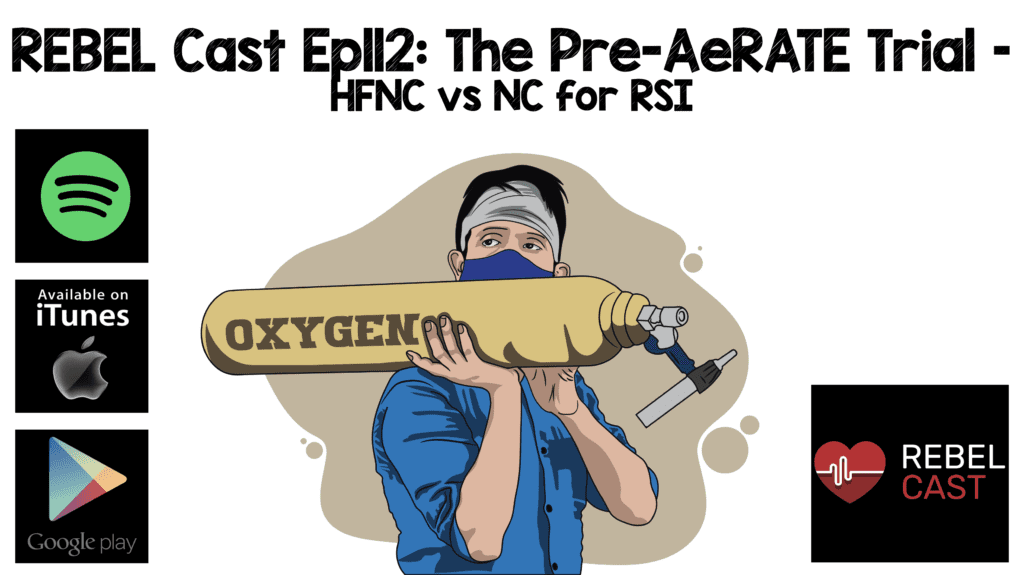
REBEL Cast Ep112: The Pre-AeRATE Trial – HFNC vs NC for RSI
Paper: Chua MT et al. Pre- and Apnoeic High-Flow Oxygenation for Rapid Sequence Intubation in the Emergency Department (the Pre-AeRATE Trial): A Multicentre Randomised Controlled Trial. Ann Acad Med Singap 2022. PMID: 35373238 [Access on Read by QxMD]
Clinical Question: Does HFNC oxygenation for preoxygenation and apnoeic oxygenation maintain a higher oxygen saturation (SpO2) during RSI in ED patients compared to usual care (Nasal Cannula)?
What They Did:
- Multicenter, open-label, randomized controlled trial
- Adult ED patients requiring RSI
- Patients randomly assigned to:
- Intervention: HFNC oxygenation at 60LPM
- Control: Non-Rebreather Mask (at flush rate O2) for preoxygenation and nasal prongs of at least 15LPM for apneic oxygenation
- Preoxygenation was for ≥3min
Outcomes:
- Primary: Lowest SpO2 during the 1st intubation attempt
- Defined as time taken from administration of paralytic agent until quantitative ETCO2 was detected post intubation if successful, or until the start of the second attempt if failed
- Secondary:
- Incidence of SpO2 falling below 90%
- Safe apnea time (duration of apnea where SpO2 remains ≥90%)
- Number of intubation attempts
- Time from induction to successful intubation
- Peri-intubation adverse events
Inclusion:
- Age ≥21 years
- Requiring RSI
Exclusion:
- Active DNR status
- Crash, awake, or DSI intubation
- Requiring NIV
- Cardiac arrest
- Suspicion or confirmed diagnosis of base of skull fractures or severe facial trauma precluding placement of NC
- Pregnant women
- Prisoners
Results:
- 190 patients included
- Top 3 indications for intubation were non-traumatic ICH, SAH and SDH (30.0%), shock states (14.7%) and seizures (12.1%)
- Most patients were assessed to have no potential airway difficulty (63.7%)
- Most patients (92.6%) were intubated using the C-MAC VL
- Median Lowest SpO2 During 1st Intubation Attempt (Primary Outcome):
- HFNC: 100%
- NRB + NC: 100%
- Incidence of SpO2 Falling Below 90%:
- HFNC: 15.5%
- NRB + NC: 22.6%
- Adjusted RR 0.68; 95% CI0.37 to 1.25
- Safe Apnea Time:
- HFNC: 10min
- NRB + NC: 7.0min
- HR 0.57; 95% CI 0.28 to 1.12
- Outcomes were comparable between groups in respect to:
- Number of intubation attempts
- Time to successful intubation
- Successful 1st Pass Intubation:
- HFNC: 82.5%
- NRB + NC: 83.9%
- Median Time from Induction to Successful Intubation:
- HFNC: 3.0min
- NRB + NC: 3.5min
Strengths:
- Asks a clinically important question for a complication that can occur frequently in the ED
- A research coordinator, nurse, or clinician not involved in the intubation recorded the lowest SpO2
- Near 100% follow up in the intention-to-treat analysis
- Performed a post-hoc analysis of patients who were in extremis which showed the potential to desaturate faster or have a more challenging intubation
Limitations:
- Unblinded trial: ED team and patients were not blinded and therefore knew what interventions they were getting.This could impact the results of more subjective outcomes
- Largest proportion of patients were patients with neurologic emergencies not pulmonary emergencies meaning they most likely had better physiological reserves for oxygenation
- >50% of patients in both groups maintained SpO2 at 100% during the intubation attempt due to better cardiorespiratory reserves and low risk of desaturation
- Convenience sample of patients which could create a selection bias
- Primary outcome is a monitor-oriented outcome.Meaningful conclusions regarding patient-oriented outcomes (i.e. mortality) could not be made
Discussion:
- This study does not apply to crash intubations.Of the 518 patients screened, 326 were excluded due to the need for crash intubation (patients unconscious and apneic)
- The control group (NRB + NC) seemed sicker when looking at baseline differences compared to the intervention group (HFNC) with more
- Septic shock (14.0 vs 6.2%)
- Vasopressor use (14.0 vs 7.2%)
- Reduced mouth opening (34.4 vs 25.8%)
- What this study tells me:
- In patients with non-difficult airways and not in cardiopulmonary extremis the use of NRB + NC is just as good as HFNC for preoxygenation and apneic oxygenation
- In patients with perceived difficult airways (potential longer apnea time) or patients in more cardiopulmonary extremis requiring PEEP to overcome shunt/dead space physiology and cannot tolerate NIV due to obtundation, emesis, or inability to tolerate the mask, a nice intermediary step could be HFNC
- In patients in extremis, compared to NRB + NC there was a lower risk of SpO2 falling below 90% and a longer safe apnea time of ≈3min
Author Conclusion: “Use of HFNC for preoxygenation and apnoeic oxygenation when compared to usual care, did not improve lowest SpO2 during the first intubation attempt but may prolong safe apnoea time.”
Clinical Take Home Point: I am not surprised by these results. In a population of predominantly neurologic emergencies, HFNC used for preoxygenation and apneic oxygenation did not show improvement in median lowest SpO2 achieved during the 1st intubation attempt. However, HFNC did seem to prolong safe apnea (≈3min) and decrease the risk of SpO2 falling below 90% compared to NRB + NC. HFNC could be considered as an intermediary step for patients in cardiopulmonary extremis or with perceived difficult airways when not tolerating NIV.
References:
- Chua MT et al. Pre- and Apnoeic High-Flow Oxygenation for Rapid Sequence Intubation in the Emergency Department (the Pre-AeRATE Trial): A Multicentre Randomised Controlled Trial. Ann Acad Med Singap 2022. PMID: 35373238 [Access on Read by QxMD]
Post Peer Reviewed By: Anand Swaminathan, MD (Twitter: @EMSwami)



